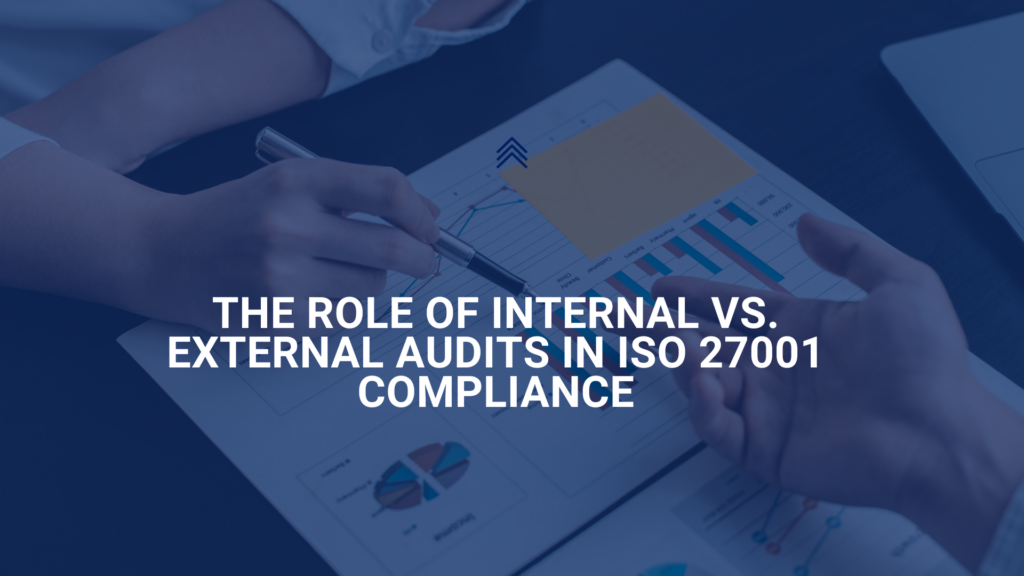
Achieving and preserving ISO 27001 certification requires businesses to set up a sturdy Information Security Management System (ISMS). Audits are a crucial part of this technique, making sure that the ISMS is efficient and compliant with the standard. These audits fall into fundamental categories: internal and external audits. Each performs a unique function within the compliance journey, presenting specific advantages and disadvantages.
This blog explores the important and fundamental variations among internal and external audits, their advantages, and the way businesses can navigate the demanding situations they present.
Understanding Internal Audits
Internal audits are carried out by the company itself or through internal groups specially skilled for the task. Their number one aim is to assess the effectiveness of the ISMS and discover problematic areas. Hence, figuring out areas of development before external scrutiny.
Key Features of Internal Audits:
- Frequency: Internal audits are regularly carried out more often than external audits, for instance, it may be done quarterly or bi-annually.
- Scope: Depending on organizational needs and requirements, they can focus on unique components of the ISMS or cover the complete system.
- Flexibility: Internal audits are much less rigid, permitting businesses to customize the audit technique and scope to deal with particular concerns.
Advantages of Internal Audits:
- Proactive Identification of Issues: Internal audits assist perceive potential non-conformities and vulnerabilities beforehand. Hence, the issues can be catered to before the external audit.
- Cost-Effective: They remove the need for external auditors, lowering expenses.
- Employee Involvement: Engaging internal groups fosters a lifestyle of ownership and attention related to data security.
- Continuous Improvement: Internal audits permit everyday feedback loops, promoting ongoing ISMS optimization.
Challenges of Internal Audits:
- Potential Bias: Internal auditors can also additionally lack objectivity because of their familiarity with the system.
- Resource Limitations: Small companies can also additionally lack skilled employees to conduct thorough audits.
- Lack of Expertise: Internal teams might not have the deep technical expertise and knowledge required for complete evaluations
Understanding External Audits
External audits are carried out through independent certification bodies or third-party auditors. Their goal is to confirm and verify compliance with ISO 27001 compliance and issue the certification upon successful completion.
Key Features of External Audits:
- Impartiality: Conducted through independent professionals, it ensures objectivity. Hence, proving authentic and unbiased reports.
- Certification-Oriented: Focused on figuring out whether or not the company meets ISO 27001 requirements.
- Structured Approach: External audits comply with a predefined method and timeline, usually divided into stages (e.g., Stage 1 and Stage 2 audits).
Advantages of External Audits:
- Credibility: Certification through an independent and impartial body enhances the company`s recognition and reputation. Moreover, it also instills trust among customers and stakeholders.
- Expertise: External auditors convey specialized expertise, knowledge, and experience, presenting valuable insights.
- Compliance Assurance: An external audit is the very last step in reaching ISO 27001 certification.
- Market Competitiveness: Certification achieved through an external audit can differentiate a company in competitive markets.
Challenges of External Audits:
- High Costs: External audits may be expensive, particularly for small businesses.
- Stressful Preparation: The certification technique may be intense, requiring significant guidance, preparation, and resources.
- Limited Control: Organizations should adhere to the external auditor`s time table and technique.
- Potential Nonconformities: Unaddressed problems recognized at some point of external audits can put off and delay the certification process.
Comparing Internal and External Audits
| Aspect | Internal Audits | External Audits |
| Purpose | Identify and resolve internal issues | Verify compliance and issue certification |
| Frequency | Conducted regularly based on organizational needs | Typically annual or as required for certification |
| Cost | Lower, utilizing internal resources | Higher, involving external auditors |
| Expertise | Relies on internal knowledge | Leverages specialized external expertise |
| Objectivity | This may be biased due to familiarity | Highly objective and impartial |
| Outcome | Internal improvements | Certification or Renewal |
Achieving Balance Between Internal and External Audits
Both internal and external audits are crucial for ISO 27001 compliance. Internal audits lay the foundation for addressing problems proactively, while external audits offer unbiased validation of compliance. To maximize their benefits, businesses need to focus on:
- Building Internal Expertise: Train internal auditors to make sure they have the expertise and abilities to conduct effective and efficient audits.
- Leveraging External Insights: Use feedback from external audits to refine internal practices and enhance the ISMS.
- Integrating Audits into the ISMS Cycle: Align internal and external audits with the organization`s common hazard control and non-stop development strategies.
- Resource Allocation: Invest in each internal training program and external audit services to ensure a balanced method.
Conclusion
Internal and external audits function as complementary components of ISO 27001 compliance. Internal audits provide businesses the power to enhance continuously, while external audits offer the credibility and validation needed to gain certification. By understanding the differences, advantages, and challenges of each, businesses can develop a sturdy audit approach. This will not only guarantee compliance but also complement the effectiveness of their ISMS. In today`s landscape of developing cybersecurity threats, a well-balanced method of auditing is crucial for retaining trust, shielding sensitive information, and attaining long-term success. Visit our website to get more information.
